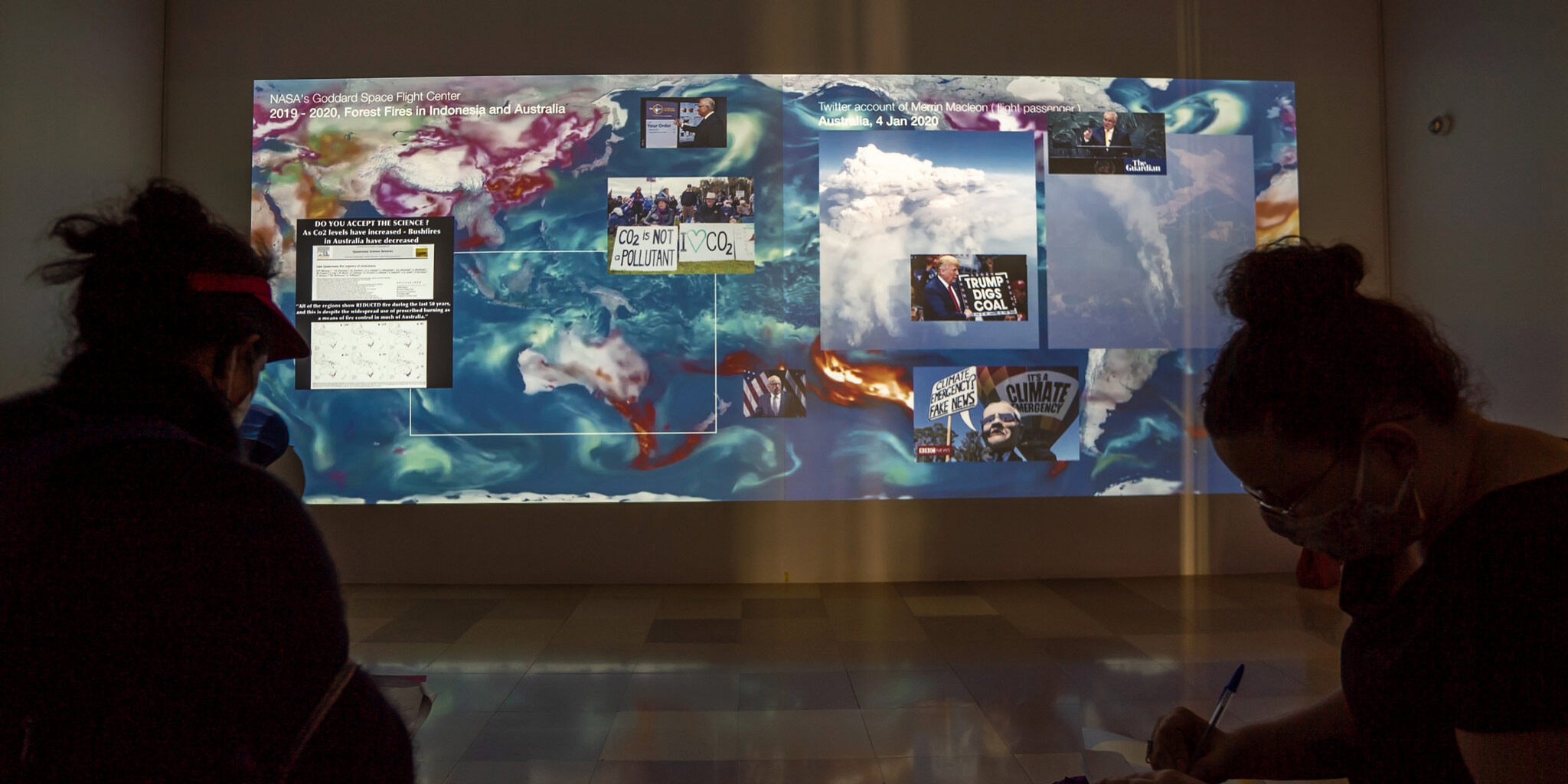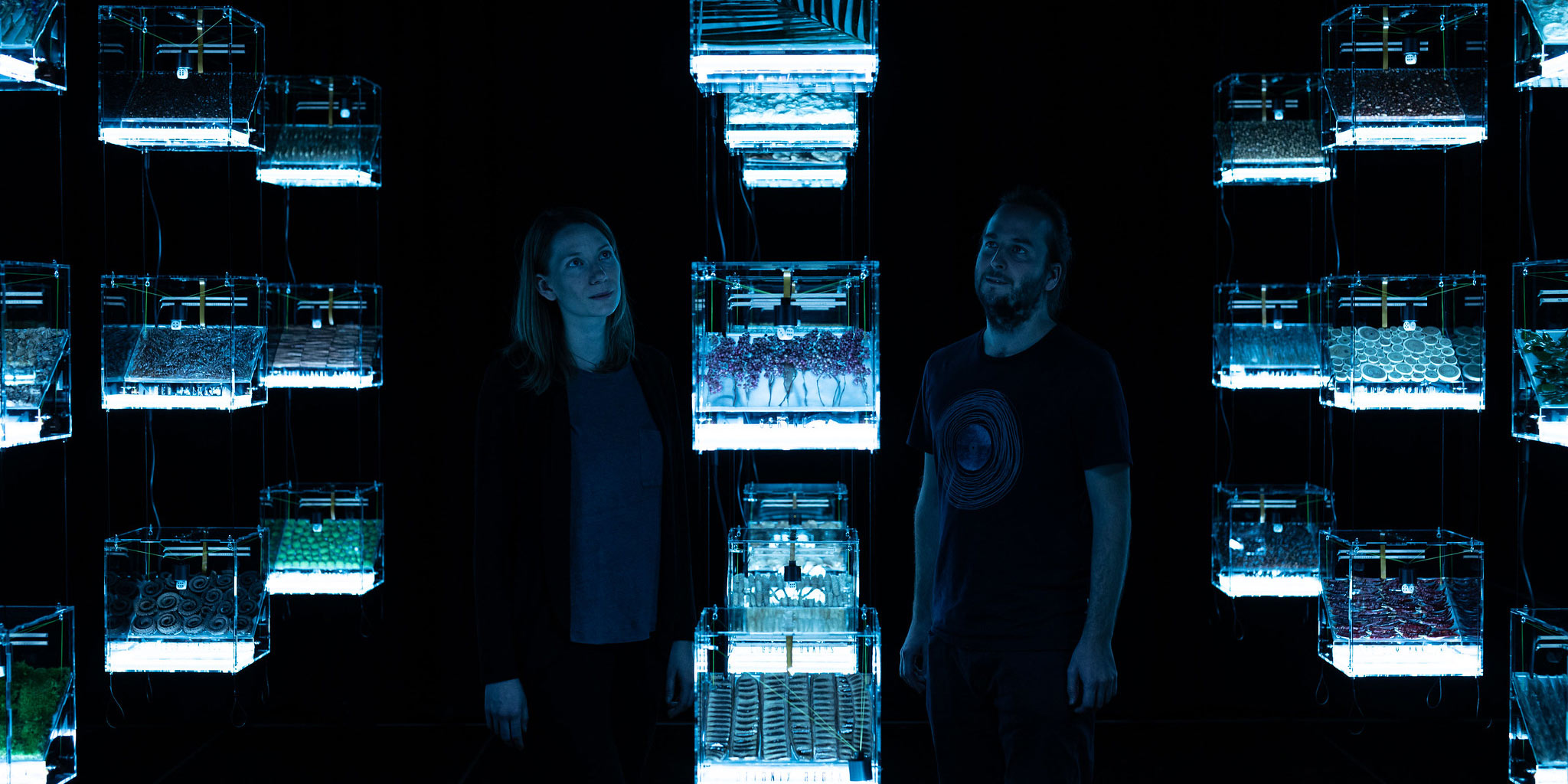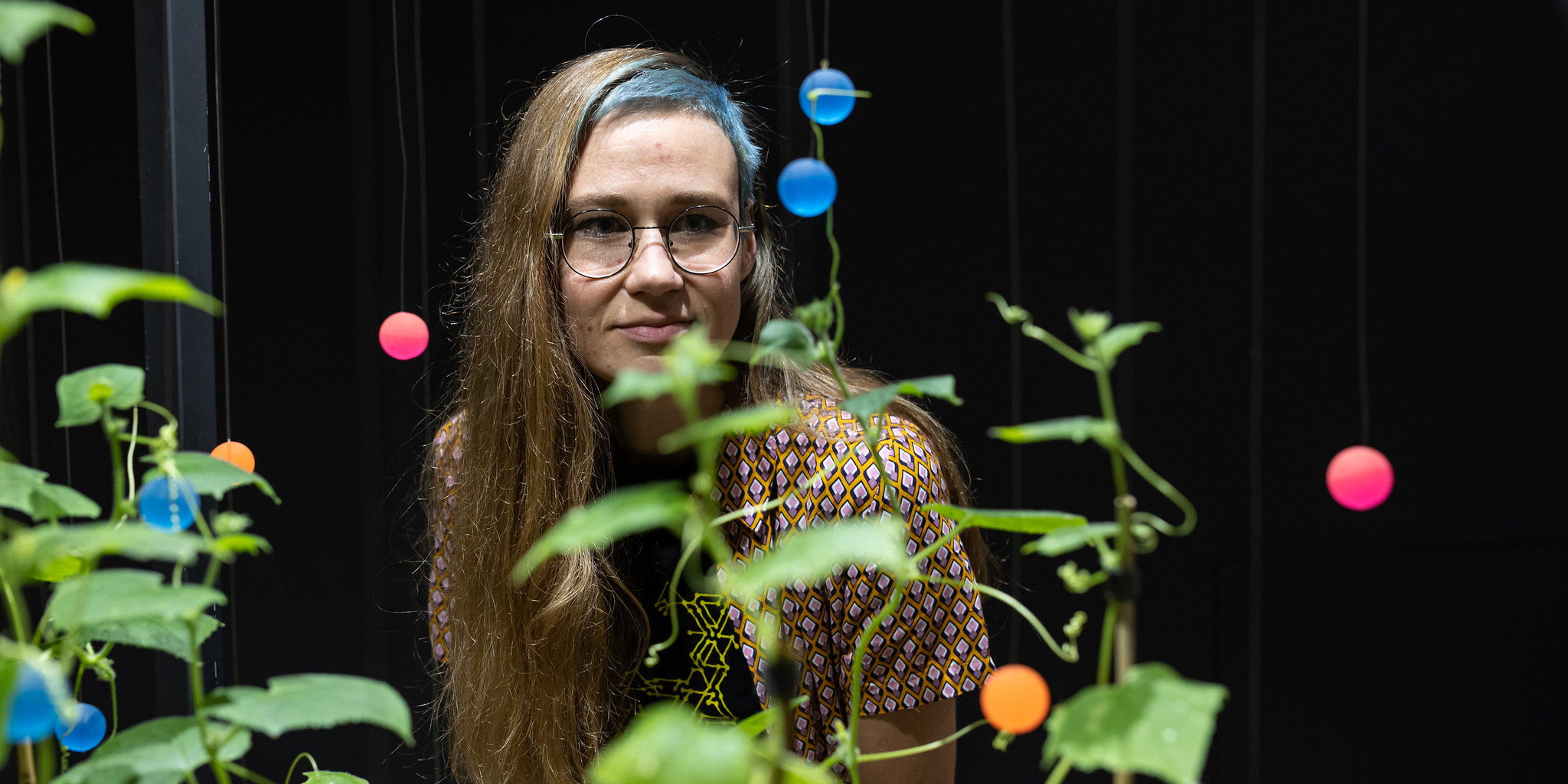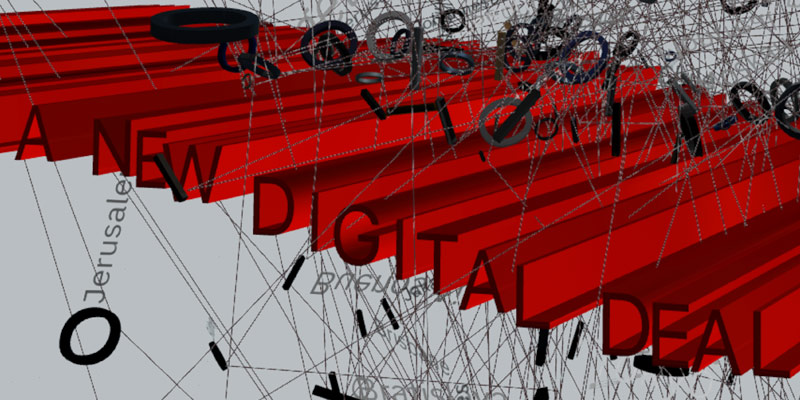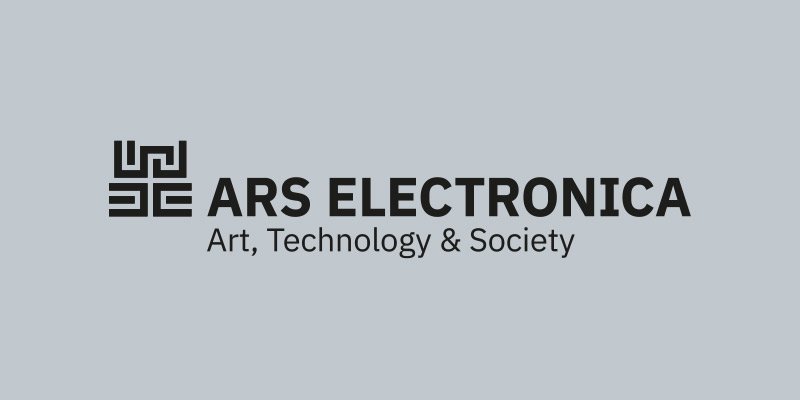The new category Artificial Intelligence & Life Art is dedicated to artistic practice and thinking related with all areas of Artificial Intelligence and Life Sciences. Rewarded are artworks engaging critically and highly qualitative with Biotech, Genetic Engineering, Life Sciences as well as Robotic and Kinetic, Machine Learning, Deep Learning and any other form of Artificial Intelligence Research.
Honorary Mention
Sound For Fungi. Homage To Indeterminacy, 2020
Theresa Schubert (DE)
Sound for Fungi. Homage to Indeterminacy began as a laboratory experiment in which Schubert played sinus frequencies to fungi mycelia she collected from forests near her home in Berlin. After weeks of observing, most of them showed a positive response to the influence of sound by growing faster and denser than samples grown in silence. The interactive and generative video installation simulates Schubert’s experiment. Audiences can explore this biological process by using a tracking sensor, whereby hand movements simulate the role of a sound frequency and change the fungi’s growth in real time. The title refers to the American composer John Cage’s development of “indeterminacy” as an improvisational technique in which aspects of a composition are left open to chance, nature, or free choice. Improvisation—not so much as a musical process but understood as a natural life phenomenon—represents a condition of existence itself. With her work, the artist facilitates an interspecies experience which works best when visitors bring tranquility and patience to their interaction.
Credits
Installation
Studio assistant: Simona Dossi
Simulation development: Sage Jenson
Produced within the “Mind the Fungi research project by TU Berlin and ALB
theresaschubert.com
Golden Nica
Cloud Studies, 2020
Forensic Architecture (INT)
Forensic Architecture is a research agency comprising architects, artists, filmmakers, journalists, lawyers, scientists, and software developers that investigates state and corporate violence. The agency’s investigations employ pioneering techniques in the fields of spatial and architectural analysis, open source investigation, and immersive technologies. The FA team investigates, explores, and exposes how power reshapes the very air we breathe. Tear gas is used to disperse bodies gathering in democratic protest, white phosphorus and chlorine gas are used to spread terror in cities, herbicide is sprayed from airplanes to destroy fields and displace those whose livelihood depends on them, arson is used to eradicate forests for industrial plantations. Mobilized by state and corporate powers, toxic clouds colonize the air we breathe. Cloud Studies brings together eight recent investigations by Forensic Architecture, each examining different types of toxic clouds and the capacity of states and corporations to occupy airspace and create unlivable atmospheres. Combining digital modelling, machine learning, fluid dynamics, and mathematical simulation in the context of active casework, it serves as a platform for new human rights research practices directed at those increasingly prevalent modes of “cloud-based,” airborne violence.
Credits
2-channel video installation (23′ 28″)
multi-channel video installation on 5 monitors, length:various
Originally commissioned by ZKM Centre for Art and Media in Karlsruhe
forensic-architecture.org/investigation/cloudstudies
Honorary Mention
Capture, 2020
Paolo Cirio (IT)
Paolo Cirio’s works embody the contradictions, ethics, limits, and potentials inherent in the social complexity of information society through a provocative, critical, and proactive approach—as seen in his projects about Google and Facebook. Capture examines facial recognition as used in Europe by authorities and companies without a clear legal framework. The artist used facial recognition software to filter out the faces of 4,000 police officers from over 1,000 photos taken during protests in France. Using crowdsourcing, he identified them by name on an online platform and posted the officers’ headshots as street art posters throughout Paris. This deliberately provocative action comments on the potential of facial recognition and artificial intelligence. The lack of privacy regulations for such technology eventually turns it against the same authorities that urge its use. This provocation triggered reactions by France’s Interior Minister and the police unions, leading to the censorship of the artwork.
Credits
Installation, Video This work was a co-production between Le Fresnoy – Studio national des arts contemporains in Fresnoy and La Condition Publique in Roubaix, France.
paolocirio.net
ban-facial-recognition.eu
Award of Distinction
TX-1, 2020
Tranxxeno Lab / Adriana Knouf (US)
While we (humans) refer to potential life in outer space as “aliens,” queer and transgender life on Earth is likewise still often referred to as “alien.” tranxxeno lab by Adriana Knouf addresses the biochemical requirements of transgender persons in outer space, especially their need for hormone replacement medication. TX-1 launched bits of these medications to the International Space Station (ISS), marking the first-known time that elements of the transgender experience orbited the Earth. TX-1 includes a fragment of Knouf’s spironolactone pill, a slice of her estradiol patch, and a miniature paper sculpture, as a gesture towards the absent-yet-present xenoentities of the cosmos. A symbolic exodus, the return of TX-1 to Earth was also a sign of resilience. The project draws attention to the fact that all human bodies are subject to individual, societal, and environmental changes, and that all people need support and care for their survival—whether on Earth or in space.
Credits
Installation
TX-1 box design and modeling:Felipe Rebolledo
Machining: Jože Zajc, David Pilipović
TX-1 was selected through MIT Media Lab Space Exploration Initiative’s first international artwork open call to the ISS and the launch opportunity was provided by the initiative. It flew to the ISS as part of Sojourner2020 which included eight other artist groups. Additional support: Northeastern University.
zeitkunst.org
tranxxenolab.net/projects/tx-1
Honorary Mention
The Transparency Of Randomness, 2020
Vera Tolazzi (AT), Mathias Gartner (AT)
In this interactive installation, visitors can directly experience the significance of the complex interplay of randomness and stochastics in current mathematical and physical research. 27 transparent boxes, floating in space, continuously generate random numbers by using the wellknown medium of dice. The process of random number generation is influenced by the complexity of nature and its structures, using a variety of natural materials such as cinnamon, moss, cotton, and cork that have special haptic properties like being soft, rough, hard-edged, or fluffy. Each roll of the dice thus takes on completely different characteristics. Visitors have the opportunity to control one of the boxes by accessing a web application and therefore become an active part of the installation with their self-generated random number. The ensemble of all generated random numbers forms the basis for a real-time calculation and generative graphics. With this project the artists want to demonstrate the importance of random numbers in various fields of research, such as artificial intelligence, physics, computer simulations, and machine learning.
Credits
Installation Support received from: Land Oberösterreich and Johannes Kepler University Linz
veratolazzi.com
Award of Distinction
The Museum Of Edible Earth, 2017 ongoing
masharu (NL/RU)
The Museum of Edible Earth is a cross-disciplinary project with, at its core, a collection of 400 samples of types of earth that are eaten for various reasons by different people across the globe. It invites the audience to physically question our relationship to the environment and the Earth, and to review our knowledge about food and cultural traditions using creative thinking. Masharu aims to re-introduce geophagy—the practice of eating earth and earth-like substances, such as clay and chalk, an ancient spiritual and healing practice in various countries in Africa, Asia, and Latin America. The Museum of Edible Earth is beeing presented In Kepler’s Gardens / Campus of the Johannes Kepler University.
Credits
Documentation Credits: SasaHara (FR), project manager
masharu.nl
museumofedible.earth
Honorary Mention
Compasses, 2019
Allison Parrish (US)
A machine learning model of spelling and phonetics invents new words in negative spaces between supposedly discrete categories. The model was trained by Allison Parrish with two parts: a “speller,” which spells words based on how they sound, and a “sounder-out,” which sounds out words based on how they’re spelled. In the process of sounding out a word, the “sounder-out” produces a fixed-length numerical vector, known as a “hidden state,” which is essentially a condensed representation of a word’s phonetics. The “speller” can then use the phonetic information contained in this hidden state to produce a plausible spelling of the word. Compasses is a collection of poems resulting from this process.
Credits
Installation
portfolio.decontextualize.com/#compasses
Honorary Mention
Slave Rebellion Reenactment, 2019/21
Dread Scott (US)
Slave Rebellion Reenactment (SRR) is a community-engaged artist performance and film production that, in November 2019, reimagined the German Coast Uprising of 1811—the largest rebellion of enslaved people in US history. Envisioned and organized by artist Dread Scott and documented by filmmaker John Akomfrah, SRR animated a suppressed historical event with an audacious plan to organize and seize Orleans Territory, to fight not just for their own emancipation but to end slavery. In contrast to many war reenactments, much of SRR was a procession that was jarringly out of place, as over 300 people, many on horses, armed with prop weapons, in 19th-century garments, advanced past the gated communities, mobile homes, fast food restaurants, and oil refineries. SRR initiated several recruitment and organizing meetings that took the form of conversations about why people chose to participate and why this history is important in contemporary society. What would success have meant for US and world history? This project wants to help people of all races to rethink long-held assumptions and broaden their vision of what is possible.
Credits
Installation & Video
slave-revolt.com
Honorary Mention
The Cleanroom Paradox, 2020
Felix Lenz (AT), Angela Neubauer (AT), Eszter Zwickl (HU)
The Cleanroom Paradox dismantles the deceptively pristine image of the high-tech industry and unveils the systemic suppression of occupational, toxic hazards at semiconductor production sites. Jin is a former Samsung factory worker whose employer failed to acknowledge the lack of adequate precautionary health measures during work procedures. After her time in the industry, she is left alone to deal with the drastic consequences: a kidney cancer diagnosis. The work comprises a gradually disintegrating, custom print of Jin and a video documenting the portrait’s creation. The video essay is superimposed with her own as well as experts’ personal stories, shedding light on the industry’s latent practices. The artists use chemically dissolved smartphones as ink for screen printing the worker’s portrait. Analogous to the industry’s etching processes, the toxic agent will corrode the print over time, skinning a surface whose lower layers are already inscribed with Jin’s story.
Credits
Installation & Video (11′ 03″) Produced at and supported by: Design Investigations (ID2) University of Applied Arts Vienna
felixlenz.at
Honorary Mention
PL’AI, 2020
Špela Petrič (SI)
PL’AI by the scientist and media artist Špela Petrič explores the possibility of play between cucumber plants and an AI robot. As they grow, cucumbers search for surfaces to grab hold of, their tendrils slowly swaying through the air. A robot approaches the plants with 36 individually controlled wires suspended from above, moving only as fast as the tendrils of the plants. It senses the cucumbers and feeds the images through a neural network, which in turn decides how to approach the plants by moving the colored balls. With each touch, the cucumbers impact the algorithm and gradually transform the robot’s steel tendrils into a trellis that supports their growth. The play between the cucumber and robot leaves morphological traces in the shape of the plants, the steel strings, and the neural network. A time-lapse recording of the last 24 hours of play, which captures the tendrils’ and balls’ movement, shows this process.
Credits
Installation The project is produced by Kapelica
Gallery / Kersnikova Institute
spelapetric.org/#/plai
